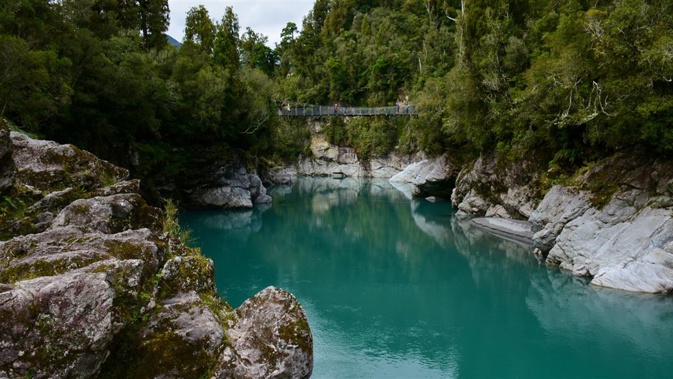
Hemmed in by the Tasman Sea and the serrated peaks of the Main Divide, there really is no region in New Zealand quite like Westland. It’s pitch-perfect for an autumn road-trip. After traversing the Southern Alps, and spilling out in Kumara, my first stop was just south of Greymouth at Shanty Town, a faithfully re-created 1860s gold-mining town, complete with pub and post office. There are lots of interactive experiences to try your hand at, including gold-panning, sawmilling and the far more leisurely pursuit of the miniature train rides.
Highlights include the cluster of 30 gold rush era buildings, painted in the bright colours of boiled sweets. Enjoy a tipple in the evocative Golden Nugget Hotel, learn the art of gold panning and enjoy the short movie in the opulent Victorian-themed theatre, where holographic technology brings to life the extreme stories of hardship and danger characteristic with the gold boom. But the prize draw are the steam train rides following an original bush tram-line through native rainforest, replete with vestiges of the goldmining era.
Heading further south on SH6, I went as far as Ross, a cute-as-a-button settlement, with a storied past in gold-mining. The historic village of glories lost sports a cluster of colonial buildings, including the old Ross jail and miners’ cottages. The 150-year old Empire Hotel (the current building dates from 1908) is one of the most treasured on the Coast, bursting with history, personality and great pub cuisine. Whitebait, anyone?
From Ross, I ventured back up SH6, to take in a recent addition to Westland’s stable of top-billing attractions. Turning off the highway on to the Woodstock-Rimu Rd, the $7 million Treetops walk is a series of elevated steel walkways allowing you to traverse the canopy of the podocarp forest by Lake Mahinapua. 25 metres above the forest floor, the mesh-steel gantry leads you through a dense vista of native forest, with giant specimens of rimu, kamahi and matai, interspersed with tree ferns, orchids, liverworts and fellow forest floor residents.
Lush and intimate, the highpoint is the 47metre high spiral staircase leading you up to lofty views of the forest, Lake Mahinapua and the mountains of Westland. The lovely Treetops staff, who will equip you with a brolly if it’s wet, advised me their most frequently asked question is how to get to Hokitika Gorge from here. And if you have the time, Treetops is the perfect starting point for a grand circuit of the Hokitika Valley, lacing a slew of striking spectacles into one great hinterland drive.
From Treetops, head to Rimu and Woodstock, two pint-sized vestiges of the goldmining legacy, with a spectacular lookout over the Hokitika River and panels illustrating one of the Coast’s last great gold rushes. Follow the signposts to Kokatahi and Kowhitirangi. The West Coast’s multitude of vivid greens comes into sharp focus as you wend your way through the fertile farmland. From here, a short gravel road leads you to one of my favourite New Zealand settings, the ravishing granite ravine of Hokitika Gorge.
Sometimes you’ll see a photo of brochure perfection of a scenic spot and you think, yeah right, I better it doesn’t look that good in the flesh. But Hokitika Gorge is one of the rare exceptions where the setting is as dreamy as reality gets, deep in the Whitcombe Valley. Right by the Alpine Fault, surrounded by dense native bush, thronging with native birds, the turquoise water is so absurdly vivid and otherworldly, it looks photo-shopped. (It’s due to the glacial flour seeping into the water.)
But after heavy rain, the water turns a soupy grey, so you will be at the mercy of the weather gods. I struck a mix of milky blue and grey. Either way, cross the swing bridge and take in the enchanting bush walks, adjacent to the gorge. After you’ve had your fill of turquoise glory, complete your valley circuit by following the sign posts around the eastern side of Lake Kaniere, taking in the lusty waterworks of Dorothy Falls. If it’s been raining heavily, the upside to nature’s vagaries is that the falls will be gushing like a fire hydrant. Directly adjacent to the road, it’s the easiest, shortest of walks to waterfall wonder. From there, a plethora of lakeside spots beckoning you to pause, before completing the circuit in Hokitika.
You’d be hard pressed to find any other town or city in New Zealand with more galleries, studios and arty types. Within this creative powerhouse, you could spend all day wandering the wide streets of Hokitika, admiring the studios, talking to the painters, glass blowers, craftspeople and pounamu carvers. Scattered across windswept, wave-lashed Hokitika Beach, the sculptural driftwood art is ever-evolving. Unleash your own creative juices and assemble something, while you’re there. If you’ve ever seen those iconic West Coast stone mats, fashioned as door mats or table mats, Waters Edge headquarters is just out of town, on the Kumara Junction Highway. They make for a trusty, totally usable memento.
I stayed at Shining Star Beachfront Accommodation in Hokitika. With a supreme beachfront location and nestled in a garden landscape, Shining Star boasts homely self-contained beachfront chalets with free WiFi and a private balcony just steps from the ocean and sunsets to die for. Pack your pooch, it’s dog-friendly too. I booked through Wotif.co.nz who offer travellers access to millions of rooms, hundreds of airlines and thousands of destinations both locally and around the world. You can search, plan and book your next trip in the one place and have access to special package savings when you combine a hotel and flight in the same booking. www.wotif.co.nz
Mike Yardley is our Travel Correspondent on Jack Tame Saturday Mornings.
Take your Radio, Podcasts and Music with you







